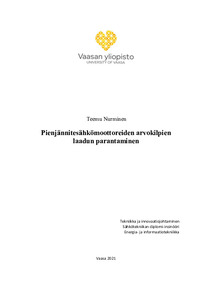Pienjännitesähkömoottoreiden arvokilpien laadun parantaminen
Nurminen, Teemu (2021-02-26)
Nurminen, Teemu
26.02.2021
Julkaisun pysyvä osoite on
https://urn.fi/URN:NBN:fi-fe202102266108
https://urn.fi/URN:NBN:fi-fe202102266108
Tiivistelmä
Laadulliset virheet aiheuttavat yrityksille hukkatyötä sekä ylimääräisiä kustannuksia. Tämän työn tarkoituksena on selvittää ABB oy Motors & Generators -yksikön Vaasan toimipisteen sähkömoottoreiden arvokilpien laadullisia virheitä. Selvitetään syntyneiden virheiden laatu eli miten usein ja millaiset virheet sähkömoottoreiden arvokilvillä esiintyvät. Tämän tiedon avulla voidaan keskittyä usein ilmeneviin ja vaativiin virheisiin ja käydä läpi virheellisen informaation kulku yksikön tilaus-toimitusprosessissa. Tästä informaatioprosessista tarkastellaan kohtia, joissa virheitä tapahtuu, sekä tehdään ehdotuksia virheiden määrien vähentämiseksi.
Työhön tarvittava informaatio kerättiin Vaasan Motors & Generators -yksikön eri järjestelmistä ja sen perusteella tehdään ehdotuksia tilaus-toimitusprosessin sekä laadunvalvonnan parantamiseksi. Tätä informaatiota käsiteltäessä käytettiin Lean Six Sigman DMAIC-, Pareto-kaavio-, aivoriihi- sekä syyseuraus-menetelmää. Kerätystä informaatiosta saatiin selville, että eniten virheitä on tapahtunut sähkömoottoreiden pääarvokilvissä ja liittyivät suurimmaksi osaksi pääarvo-arvokilven leimausriveihin. Tämän lisäksi havaittiin, että suunnittelijoilla on myös suuri vaikutus arvokilpien virheisiin liittyen juuri leimausrivien virheisiin. Sen sijaan sähkömoottorityypillä, runkokoolla tai asiakkaalla ei ollut suurta vaikutusta tarkasteltaviin reklamaatioihin. Syitä arvokilpien virheisiin löytyi tilaus-toimitusprosessin alkupään sekä suunnittelun väliltä.
Korjaavina toimenpiteinä ehdotetaan muun muassa arvokilpien suunnitteluohjeen uusimista, arvokilpien suunnitteluun automatisointia, muutoksia OMS-järjestelmän sisältöön ja datan siirtoon sekä muutoksia Elapp-suunnitteluohjelmaan. Lisäksi tehtiin ehdotuksia uusien työntekijöiden perehdyttämiseen sekä muihin työohjeisiin. Quality errors cause companies extra work as well as additional costs. The purpose of this work is to find out the qualitative defects in the rating plates of low voltage electric motors produced by ABB oy Motors & Generators unit in Vaasa. The aim is to find out the reasons of the errors that occur and to find how often and what kind of errors occur on the rating plates of low voltage electric motors. With the help of this information, it is possible to focus on frequently occurring and demanding errors and to go through the flow of incorrect information in order-delivery process. From this information process, we find the points where errors occur and make suggestions to reduce the number of errors.
The information needed for the work was collected from various systems of Motors & Generators and based on this information, suggestions are made to improve the order-delivery process and quality control. We used in this study Lean Six Sigmas DMAIC, Pareto chart, brainstorming and cause-and-effect method. From the information collected, it was found that the most errors have occurred on the main rating plates of electric motors and they were mostly related to the stamping rows of the rating plate. In addition to this, designers also had a huge impact on rating plate errors related to stamping rows. However, type and size of electric motor and customer had no significant impact on the number of claims from customers. Reasons for the errors on the rating plates were found between the beginning of the order-delivery process all the way to the planning of the electric motor.
Remedial measures suggested include the renewal of the rating plate design guide, automation of the nameplate design, changes to the OMS in regards its content and data transfer, and changes to the Elapp design software. In addition, suggestions were made for the orientation of new employees and to some other work instructions.
Työhön tarvittava informaatio kerättiin Vaasan Motors & Generators -yksikön eri järjestelmistä ja sen perusteella tehdään ehdotuksia tilaus-toimitusprosessin sekä laadunvalvonnan parantamiseksi. Tätä informaatiota käsiteltäessä käytettiin Lean Six Sigman DMAIC-, Pareto-kaavio-, aivoriihi- sekä syyseuraus-menetelmää. Kerätystä informaatiosta saatiin selville, että eniten virheitä on tapahtunut sähkömoottoreiden pääarvokilvissä ja liittyivät suurimmaksi osaksi pääarvo-arvokilven leimausriveihin. Tämän lisäksi havaittiin, että suunnittelijoilla on myös suuri vaikutus arvokilpien virheisiin liittyen juuri leimausrivien virheisiin. Sen sijaan sähkömoottorityypillä, runkokoolla tai asiakkaalla ei ollut suurta vaikutusta tarkasteltaviin reklamaatioihin. Syitä arvokilpien virheisiin löytyi tilaus-toimitusprosessin alkupään sekä suunnittelun väliltä.
Korjaavina toimenpiteinä ehdotetaan muun muassa arvokilpien suunnitteluohjeen uusimista, arvokilpien suunnitteluun automatisointia, muutoksia OMS-järjestelmän sisältöön ja datan siirtoon sekä muutoksia Elapp-suunnitteluohjelmaan. Lisäksi tehtiin ehdotuksia uusien työntekijöiden perehdyttämiseen sekä muihin työohjeisiin.
The information needed for the work was collected from various systems of Motors & Generators and based on this information, suggestions are made to improve the order-delivery process and quality control. We used in this study Lean Six Sigmas DMAIC, Pareto chart, brainstorming and cause-and-effect method. From the information collected, it was found that the most errors have occurred on the main rating plates of electric motors and they were mostly related to the stamping rows of the rating plate. In addition to this, designers also had a huge impact on rating plate errors related to stamping rows. However, type and size of electric motor and customer had no significant impact on the number of claims from customers. Reasons for the errors on the rating plates were found between the beginning of the order-delivery process all the way to the planning of the electric motor.
Remedial measures suggested include the renewal of the rating plate design guide, automation of the nameplate design, changes to the OMS in regards its content and data transfer, and changes to the Elapp design software. In addition, suggestions were made for the orientation of new employees and to some other work instructions.
